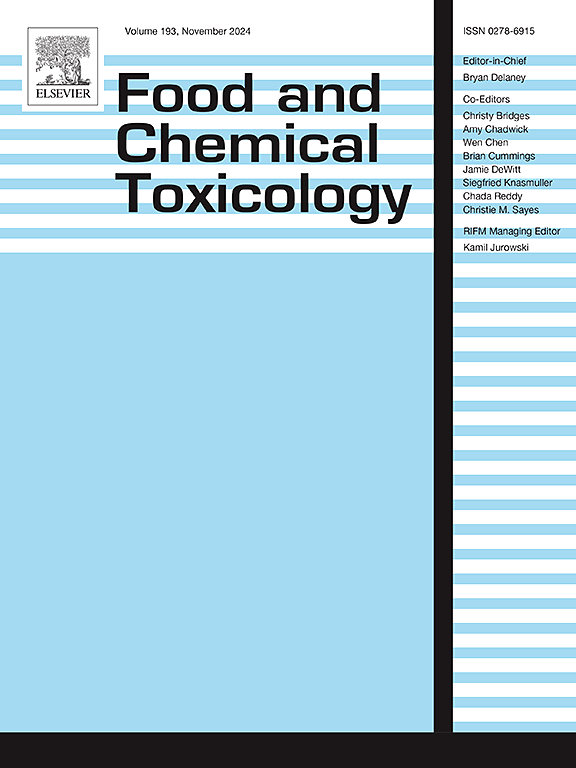奶牛在正、负能量平衡期间暴露于多氯二苯并对二恶英(pcdd)和二苯并呋喃(pcdf)、类二恶英(dl)多氯联苯(PCBs)和非dl-多氯联苯混合物对健康性状和芳烃受体(AHR)信号传导的影响
IF 3.9
3区 医学
Q2 FOOD SCIENCE & TECHNOLOGY
引用次数: 0
摘要
本研究探讨了口服二恶英和多氯联苯暴露对荷斯坦奶牛负(NEB)和正(PEB)能量平衡的影响。9头奶牛分为对照组(CON, n = 4)和暴露组(EXP, n = 5)。在NEB和PEB期间,EXP组连续28天给予278/266 pg类二恶英(dl)-PCB TEQ/kg BW/day和75/72 ng非dl-PCB /kg BW/day。评估了内暴露和健康参数。NEB期间,EXP组胆固醇水平升高较快(p = 0.049)。PEB期间,EXP组CD4+细胞比例、平均荧光强度(MFI)及CD8+细胞MFI均降低,CON组升高(p = 0.004、p = 0.05、p = 0.023)。皮下脂肪组织、脾脏和外周血单核细胞中ahr信号mRNA的表达不受影响。然而,在暴露后约100天,EXP组肝脏AHR和ARNT mRNA的表达仍然升高(p = 0.023),并与肝脏二恶英和多氯联苯残留量呈正相关(r2 = 0.43-0.75)。总体而言,二恶英和多氯联苯对检测终点的影响较小。观察到的t细胞和肝脏ahr信号变化的长期意义需要进一步研究。本文章由计算机程序翻译,如有差异,请以英文原文为准。
Effects of exposure of dairy cows to a mixture of polychlorinated dibenzo-p-dioxins (PCDDs) and dibenzofurans (PCDFs), dioxin-like (dl) polychlorinated biphenyls (PCBs), and non-dl-PCBs during the period of negative and positive energy balance on health traits and on aryl hydrocarbon receptor (AHR)-signaling
This study investigated the impact of oral dioxin and PCB exposure on Holstein cows during negative (NEB) and positive (PEB) energy balance. Nine cows were divided into control (CON, n = 4) and exposed (EXP, n = 5) groups. The EXP group received 278/266 pg dioxin-like (dl)-PCB TEQ/kg BW/day and 75/72 ng non-dl-PCBs/kg BW/day for 28 days during both NEB and PEB. Inner exposure and health parameters were assessed. Cholesterol levels increased faster in the EXP group during NEB (p = 0.049). During PEB, CD4+ cell proportion and mean fluorescence intensity (MFI), along with CD8+ cell MFI, decreased in the EXP group while increasing in the CON group (p = 0.004, p = 0.05, and p = 0.023, respectively). AHR-signaling mRNA expression was unaffected in subcutaneous adipose tissue, spleen, and peripheral blood mononuclear cells. However, approximately 100 days post-exposure, hepatic AHR and ARNT mRNA expression remained elevated in the EXP group (p = 0.023 each) and correlated positively with liver dioxin and PCB residues (r2 = 0.43–0.75). Overall, dioxin and PCB effects on the examined endpoints were minor. The long-term implications of the observed T-cell and hepatic AHR-signaling changes require further investigation.
求助全文
通过发布文献求助,成功后即可免费获取论文全文。
去求助
来源期刊

Food and Chemical Toxicology
工程技术-毒理学
CiteScore
10.90
自引率
4.70%
发文量
651
审稿时长
31 days
期刊介绍:
Food and Chemical Toxicology (FCT), an internationally renowned journal, that publishes original research articles and reviews on toxic effects, in animals and humans, of natural or synthetic chemicals occurring in the human environment with particular emphasis on food, drugs, and chemicals, including agricultural and industrial safety, and consumer product safety. Areas such as safety evaluation of novel foods and ingredients, biotechnologically-derived products, and nanomaterials are included in the scope of the journal. FCT also encourages submission of papers on inter-relationships between nutrition and toxicology and on in vitro techniques, particularly those fostering the 3 Rs.
The principal aim of the journal is to publish high impact, scholarly work and to serve as a multidisciplinary forum for research in toxicology. Papers submitted will be judged on the basis of scientific originality and contribution to the field, quality and subject matter. Studies should address at least one of the following:
-Adverse physiological/biochemical, or pathological changes induced by specific defined substances
-New techniques for assessing potential toxicity, including molecular biology
-Mechanisms underlying toxic phenomena
-Toxicological examinations of specific chemicals or consumer products, both those showing adverse effects and those demonstrating safety, that meet current standards of scientific acceptability.
Authors must clearly and briefly identify what novel toxic effect (s) or toxic mechanism (s) of the chemical are being reported and what their significance is in the abstract. Furthermore, sufficient doses should be included in order to provide information on NOAEL/LOAEL values.
 求助内容:
求助内容: 应助结果提醒方式:
应助结果提醒方式:


